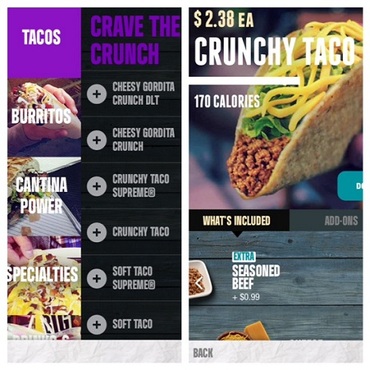Why Search Was Instrumental in the Growth of Taco Bell's App
Since relaunching its app in October, Taco Bell has found that paid search has contributed to five times the purchase strength of paid social, video, or mobile display ads.
Since relaunching its app in October, Taco Bell has found that paid search has contributed to five times the purchase strength of paid social, video, or mobile display ads.
 If you think of search, names like Google, Amazon, and Yelp probably come to mind moreso than Taco Bell. But the California fast-food chain’s app is ultimately all about search and it is responsible for much of its success.
If you think of search, names like Google, Amazon, and Yelp probably come to mind moreso than Taco Bell. But the California fast-food chain’s app is ultimately all about search and it is responsible for much of its success.
“[Consumers use the app to] search for stores, they search for products, they search for ingredients,” explains David Garcia, manager of media and brand partnerships at Taco Bell.
To draw attention to the app’s relaunch in October, Taco Bell blacked out all of its social media accounts. The content was deleted off the brand’s Facebook, Instagram, Twitter, and Google+ pages, which simply said, “TACO BELL ISN’T ON [platform]. IT’S #ONLYINTHEAPP.”

It worked – from somewhere in the thousands in the iOS App Store, the app’s position skyrocketed to the top 15 within a day. Since the relaunch, the app has amassed roughly 2 million downloads.
“We had great results – we weren’t just driving people to the landing page; we’re driving you to learn more about Taco Bell and give you the opportunity to download the app,” Garcia says. “We saw the uptick in installs with this strategy, but we now want to focus on driving quality installs measured by usage and order value.”
After the blackout, Taco Bell analyzed its success, in order to learn which factors drove the best install rates and optimize the brand’s media in the future. Paid search was key. The installs driven from paid search – Taco Bell and mobile app terms – have generated five times stronger purchase rates and nearly 10 percent higher average order values compared with other digital marketing tactics, such as social direct-response, paid social, video, and mobile display ads.
The impact of search is unsurprising, given Taco Bell’s calendar-centric marketing strategy. For a set period, different menu items are highlighted – the Triple Steak Stack is currently the primary one – so focusing on keywords, as well as expanding that list with retargeting, allows the chain to further promote its brand terms.
Taco Bell has recently adopted a mobile-first approach to its marketing, so the desktop version of the company’s website also drives installs. The page features the typical buttons linking to Taco Bell’s social media profiles, as well as iOS and Android logos directing users to their respective app stores.
“[Mobile has] allowed us to go from our advertising driving awareness of products to being more of a direct-response marketer,” Garcia says, adding that approaching search from a mobile-first perspective will continue to be a priority throughout 2015. “It’s going to continue to evolve. We’re going to continue to test and learn; I think we’re barely scratching the surface.”
Garcia calls the app buttons on Taco Bell’s desktop site “low-hanging fruit,” adding that similar calls-to-action will be added to desktop search ads later this year.